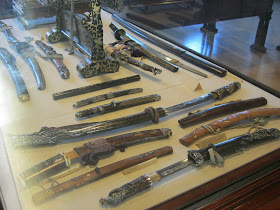The English colonist William Pynchon founded the city of Springfield, Massachusetts, naming it after his hometown of Springfield, Essex (England). While there are many Springfields in the US - that's where the long-running Simpsons' cartoon is based (though that's supposed to be Springfield, Oregon)- Springfield MA was the first to be so-named in the New World. It's not a huge city, with only 150,000 residents or so, however greater metropolitan Springfield houses nearly 700,000 inhabitants. I live about an hour's drive north of the city and often pass through on the interstate highway on my way to points further south, like Hartford Connecticut or New York City. About the only time I go to Springfield otherwise has been to visit the Woodcraft store, or, lately, for shoulder surgery.
A couple of weeks ago my wife and I decided to check out The Quadrangle, a cluster of 5 museums and the Springfield City Library, as I had heard that one of the museums had a good collection of Asian art. Not expecting a lot, I was in fact quite astounded at how good the collection was at the George Walter Vincent Smith Art Museum, which turns out to be the oldest museum in the Quadrangle. George Smith made his fortune as a carriage manufacturer in New York City and
retired when he was just 35 years old. He and his Springfield-born wife,
Belle Townsley Smith, moved to Springfield in 1871 and devoted their
lives to collecting art. Although Smith never visited Asia, by buying
from dealers in New York and Europe he became a leading 19th-century
collector of Chinese, Japanese and Middle Eastern art, and also amassed
an outstanding selection of 19th-century American paintings. The Smiths bequeathed their notable collection to begin the museum.
It was quite a stunning collection, housed in a lovely building. The Museum was completed in 1895 and has stained glass windows made by the Tiffany Glass Company in New York. I was really surprised that something so good could be found so close to home. It's funny what's in your backyard sometimes!
The museum houses a great collection of samurai armor and weaponry, a good selection of Chinese Cloissonné ware - the largest outside of China in fact, some Chinese hardwood furniture, Japanese inrō and netsuke - a lot of eye candy. I thought I'd share some pics. Sorry for the quality, as most of these were taken through glass under less than ideal lighting conditions.
Let's start with an example of the Chinese cloissonné:
From the museum's description, "Designed as a double vessel and based on the shape of a quiver, this
extraordinary piece was probably a trophy. Between the two vessels, a
falcon with spread wings subdues a monster, and a dragon on the back of
the vessel also unifies the two cylinders".
Here's an intriguing piece of pottery - two figures in a Lion dance costume:
I couldn't resist taking a picture of the earthenware jug featuring the shippō-gumi pattern on it (right):
A Japanese comb with incredible inlay work:
A Chinese huanghuali side table:
Detail:
I am always left scratching my head when I see such refined work in jade as this - how did they do it? What kind of tools did they use? How long did that take?:
A classic Chinese drum-form stool:
A superb example of Japanese metalwork:
The museum houses at least half a dozen sets of Japanese armor, which feature numerous finely-wrought details:
They even have a samurai armor storage cabinet, a type of tansu.
One of the cases showing Japanese helmets:
This small museum houses one of the largest collection of Japanese swords, daggers, and arrowheads I have ever come across. While my knowledge of the art of swords is a bit limited, I can appreciate the jewel-like metalwork that goes into the scabbards (saya) and sword hilts (tsuba). Here's a rooster-form handle on a short knife:
An overview of just one of the cases with Japanese swords:
The end of this scabbard has a delightful shrimp formed in silver:
More Japaense helmets:
And one last picture - the transom over a door in the musuem was quite unusual, so I had to take a picture:
Have you ever seen a transom like that before?
Thanks for coming by the Carpentry Way.
















Chris, thanks for this, a fascinating piece and the number of photos you include really make it more interesting especially the jade piece and the image of the Japanese armour.
ReplyDeleteOn another note its always nice for us Brits to remember how many town namesakes we have in the USA too! ;)
Adrian,
ReplyDeletethanks for your comment! Glad you enjoyed the tour, and sorry the pics weren't the greatest. Most town names in New England are English. I was born in Manchester England, my wife was born in Manchester Connecticut.
~C